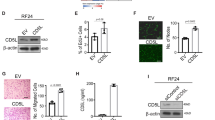Abstract
Acquired drug resistance is a major problem in the treatment of cancer. Of the more than 500,000 annual deaths from cancer in the United States1, many follow the development of resistance to chemotherapy. The emergence of resistance depends in part on the genetic instability, heterogeneity and high mutational rate of tumour cells2. In contrast, endothelial cells are genetically stable, homogenous and have a low mutational rate. Therefore, antiangiogenic therapy directed against a tumour's endothelial cells should, in principle, induce little or no drug resistance. Endostatin3, a potent angiogenesis inhibitor, was administered to mice bearing Lewis lung carcinoma, T241 fibrosarcoma or B16F10 melanoma. Treatment was stopped when tumours had regressed. Tumours were then allowed to re-grow and endostatin therapy was resumed. After 6, 4 or 2 treatment cycles, respectively, no tumours recurred after discontinuation of therapy. These experiments show that drug resistance does not develop in three tumour types treated with a potent angiogenesis inhibitor. An unexpected finding is that repeated cycles of antiangiogenic therapy are followed by prolonged tumour dormancy without further therapy.
This is a preview of subscription content, access via your institution
Access options
Subscribe to this journal
Receive 51 print issues and online access
$199.00 per year
only $3.90 per issue
Buy this article
- Purchase on Springer Link
- Instant access to full article PDF
Prices may be subject to local taxes which are calculated during checkout




Similar content being viewed by others
References
Li, P. L., Schneider, J. A. & Kantor, A. F. in Cancer Medicine 3rd edn Vol. 1(eds Holland, J. F. et al.) 322–339 (Lea & Febiger, Philadelphia, (1993)).
Morrow, C. S. & Cowan, K. H. in Cancer Medicine 3rd edn. Vol. 1(eds Holland, J. F. et al.) 618–630 (Lea & Febiger, Philadelphia, (1993)).
O'Reilly, M. S. et al . Endostatin: an endogenous inhibitor of angiogenesis and tumor growth. Cell 88, 277–285 (1997).
Brem, H., Goto, F., Budson, A., Saunders, L. & Folkman, J. Minimal drug resistance after prolonged anti-angiogenic therapy with AGM-1470. Surg. Forum XLV, 674–677 (1994).
Kerbel, R. S. Inhibition of tumor angiogenesis as a strategy to circumvent acquired resistance to anticancer therapeutic agents. BioEssays 13, 31–36 (1991).
Goldin, A. et al . Current results of the screening program at the division of cancer treatment, National Cancer Institute. Eur. J. Cancer 17, 129–142 (1981).
Hill, D. L. Review of Cyclophosphamide(Charles C. Thomas, Springfield, Illinois, (1975)).
Holmgren, L., O'Reilly, M. S. & Folkman, J. Dormancy of micrometastases: balanced proliferation and apoptosis in the presence of angiogenesis suppression. Nature Med. 1, 149–153 (1995).
Folkman, J. What is the evidence that tumors are angiogenesis dependent? J. Natl Cancer Inst. 82, 4–6 (1990).
O'Reilly, M. S., Holmgren, L., Chen, C. & Folkman, J. Angiostatin induces and sustains dormancy of human primary tumors in mice. Nature Med. 2, 689–692 (1996).
Folkman, J. Clinical applications of research on angiogenesis. N. Engl. J. Med. 333, 1757–1763 (1995).
Folkman, J. Tumor angiogenesis and tissue factor. Nature Med. 2, 167–168 (1996).
Singh, R. K. et al . Interferons α and β down-regulate the expression of basic fibroblast growth factor in human carcinomas. Proc. Natl Acad. Sci. USA 92, 4562–4566 (1995).
Acknowledgements
We thank R. Cotran for analysis of the histological sections, E. Flynn for preparation of the histological sections, K. Keough for help with protein purification, L. DeSantis for photography and S. Moscowitz of Advanced Medical Graphics for help with the figures. This study was supported by a grant to the Children's Hospital from EntreMed (Rockville, Maryland) and by NIH grants. T.B. is a recipient of an Erwin-Schrödinger-Stipendium (Fond zur Förderung der Wissenschaftlichen Forschung, Austria). T. Browder is a recipient of an American Cancer Society Career Development Award.
Author information
Authors and Affiliations
Corresponding author
Rights and permissions
About this article
Cite this article
Boehm, T., Folkman, J., Browder, T. et al. Antiangiogenic therapy of experimental cancer does not induce acquired drug resistance. Nature 390, 404–407 (1997). https://doi.org/10.1038/37126
Received:
Accepted:
Issue Date:
DOI: https://doi.org/10.1038/37126
This article is cited by
-
Angiogenic signaling pathways and anti-angiogenic therapy for cancer
Signal Transduction and Targeted Therapy (2023)
-
Recombinant human endostatin as a potential anti-angiogenic agent: therapeutic perspective and current status
Medical Oncology (2023)
-
Preclinical evaluation of a dual-receptor targeted tracer [68Ga]Ga-HX01 in 10 different subcutaneous and orthotopic tumor models
European Journal of Nuclear Medicine and Molecular Imaging (2023)
-
Rh-endostatin combined with chemotherapy in patients with advanced or recurrent mucosal melanoma: retrospective analysis of real-world data
Investigational New Drugs (2022)
-
The effect of a novel drug delivery system using encapsulated antimicrobial peptide Protonectin (IL-12) into Nano micelle PEG-PCL on A549 adenocarcinoma lung cell line
Journal of Polymer Research (2021)
Comments
By submitting a comment you agree to abide by our Terms and Community Guidelines. If you find something abusive or that does not comply with our terms or guidelines please flag it as inappropriate.



